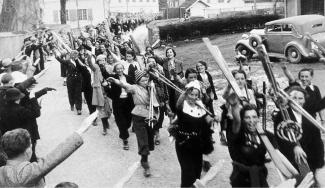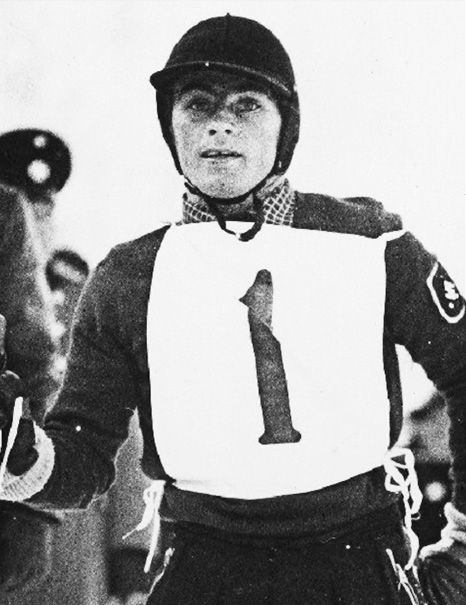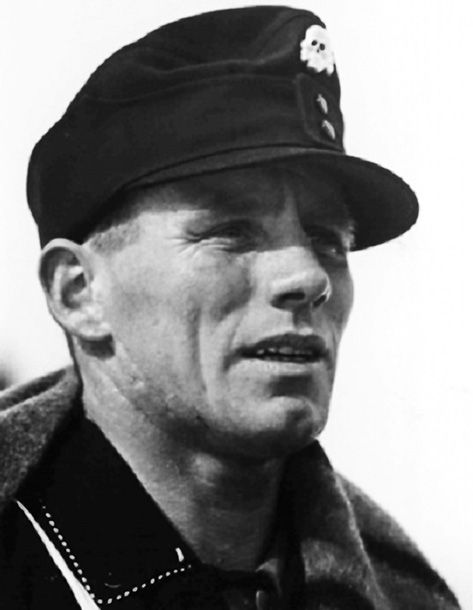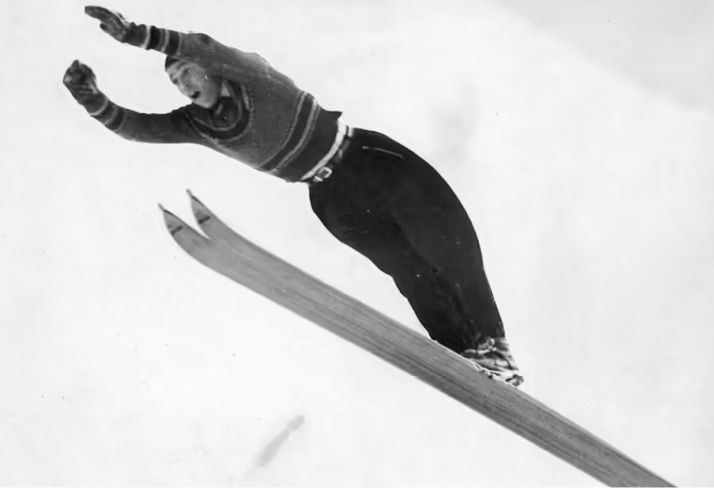Skiing in Nazi Austria

Organized sport excluded "non-Aryans" long before the Anschluss.
During the 1880s in the Austro-Hungarian Empire, an ethnic-racist worldview began spreading on the right-wing edge of the German-national movement. It postulated a supposed superiority of the “Germanic race.” The movement agitated for secession of the empire’s German-speaking regions and their subsequent unification into Germany.
Photo above: The ski team of the Dornbirn gymnastics club parades to the Turngau ski race on the Bodele, March 6, 1938. Stadtarchiv Dornbirn photo.
This radical form of pan-Germanism was driven by anti-Slavism and anti-Semitism. It brought together conservative Catholics, socialists and German nationalists of the extreme political right and shaped the political climate of both the First Austrian Republic (founded 1919) and the Austrofascist Fatherland Front, which took power in 1934 under Chancellor Engelbert Dollfuss.
The ÖSV (Austrian Ski Federation), founded in 1905, identified with this national-ethnic tradition and made racist club policy the top priority well before the establishment of the National Socialist dictatorship in Germany in 1933 and the Anschluss (annexation) of Austria to the German Reich in March 1938.

German Nationalism and Anti-Semitism
Alongside gymnastics and mountaineering, skiing was one of the first fields in which National Socialism gained a foothold in Austria. Within the ÖSV, German nationalism and, eventually, National Socialism became increasingly evident from the 1920s onward. Therefore, the Nazi takeover of skiing did not happen suddenly in March 1938 but was rather a gradual process over decades. In the German-national gymnastic movement, an anti-Semitic policy of exclusion can be traced back to the late 19th century. After World War I, this policy picked up speed in German-national sport clubs, especially in Alpine and other ski clubs of the First Austrian Republic. These associations and their members were subsequently receptive to the National Socialist racial ideology.
As in the German Turnverein (gymnastic association) and Alpenverein (Alpine club), German nationalism was the common denominator within the ÖSV, which adopted policies in the 1920s that eventually resulted in radical anti-Semitism. Long before 1938, the ÖSV excluded Jewish skiers and conformed to the “Aryan ideal” propagated by National Socialism.
The loss of World War I, the dismemberment of the empire and establishment of the First Republic deprived large portions of the Austrian population of national pride. At that point, the ÖSV saw itself as the legal association in which all “German ski clubs of the former monarchy” were to be combined. But with the conclusion of the peace treaties in 1919–20, ÖSV recognized that this was no longer possible.
With the political reorganization of Europe, the ÖSV lost German member clubs in Bohemia, Moravia, what is now Slovenia, South Tyrol and the Carpathians.
The losses were compensated by a turn to an even stronger German-national and ethnic association policy. Ethnic-minded representatives in ÖSV member clubs from Vienna to Vorarlberg not only saw the Alps as an ideal world but also understood them as German terrain.
The aim was to establish a German national hegemony in Alpine sports. That supremacy should be achieved through a political and symbolic occupation of the natural area as well as the exclusion of “non-Aryan” members.
As did other associations, the ÖSV conflated Alpinism with nationalism, and in 1923 adopted into its articles of association the Arierparagraph (Aryan paragraph), boilerplate legal language excluding Jews and Slavs. Thus, a zero-tolerance policy was developed toward anyone not of German descent.
Exclusion Policy and the Split-Up
This occurred 10 years before Adolf Hitler and the National Socialists came to power in Germany. Before adopting the Arierparagraph, in 1921 ÖSV privately asked all member clubs to submit a binding declaration. In February 1923, to underscore its pan-German goals, ÖSV chose the German national ski championships in Bad Gastein as the moment to publicly propose the amendment of its statutes. The final decision was made at a meeting of representatives on October 6 and 7, 1923, in Bad Ischl. The motion to amend the articles of association was accepted, with a clear majority of 675 to 174 votes.
Dissenting members soon split off to establish the General Austrian Ski Federation (Allgemeiner Österreichischer Skiverband, or AÖSV). AÖSV presented its own sport program and held championship competitions, open to all Austrian citizens regardless of ethnic background. The new association saw itself as apolitical and had an international focus. In the more tolerant association, the Jewish sports club Hakoah (established in 1909) and its skiers found a new home.
The exclusion of Jews led to controversy within international organizations. Nonetheless ÖSV remained the official national representative of Austrian skiing and, therefore, was economically and politically more powerful than AÖSV. In 1937, ÖSV had a network of 360 ski clubs across Austria, whereas AÖSV membership was heavily concentrated in eastern Austria, especially in and near Vienna.

Illegal Stormtroopers and Border Crossers
Even before the Anschluss, Austrian skiers represented Germany in national and international competitions. Athletes took part in National Socialist training courses and helped to shape SA and SS stormtrooper sports programs. Austrian ski instructors served the Nazi sports system, just as Austrian sports officials were entrusted with Nazi sports-political offices even before 1938.
Active athletes such as the Austrian ski jumper Josef Bradl, the first to exceed 100 meters, and downhill skier Andreas Krallinger, were organized into paramilitary associations such as the SA (Sturmabteilung, or assault division) before 1938, despite the illegality of all Austrian Nazi groups (NSDAP) under the Fatherland Front government. Other sports comrades were members of the SS (Schutzstaffel, or protective squadron). Born in December 1914, Krallinger joined the SA, at age 22, in 1936. At the same time, Bradl joined the SA in Salzburg. Bradl, 19, was then arrested for SA activities in the summer of 1937. In a letter to Salzburg Governor Franz Rehrl, written from his prison cell, the ski jumper protests his innocence. His athletic potential led to his release from custody a few months later, in time to compete in early 1938. He later became one of the most celebrated Nazi sports heroes, preparing Hitler Youth on skis for war.
Bradl’s sporting home from 1936 onward was the Skiclub Salzburg, where committed Nazis (and brothers) Hermann and Siegfried Amanshauser had leading positions. Hermann Amanshauser joined the NSDAP in May 1933 and applied for membership in the SS in 1934. As money manager of two SS units, he organized the repatriation of imprisoned National Socialists from the Austrofascist internment camp in Wöllersdorf. He was promoted to SS-Sturmmann (soldier) on December 1, 1934, and to SS-Scharführer (squad leader) on March 1, 1935. Even before the Anschluss, Amanshauser was promoted to Hauptscharführer (master sergeant), according to the SS master card transcript. He also wrote theoretical books on Alpine skiing, such as The Wonder in White (1929) and Alpine Skiing Technique (1933).
He belonged to the Alpine Club (Alpenverein) and was responsible for training the youth there. His brother Siegfried joined the NSDAP in 1932 and the SS in 1937.
From the 1930s on, and increasingly after Hitler’s takeover in Germany in 1933, demonstrations of support for National Socialism in Austrian ski circles accumulated. Especially in the run-up to the failed July Putsch in 1934, in which Chancellor Dollfuss was killed by Nazis, National Socialist demonstrations at competitions and skiing events increased. In Kitzbühel, the Hahnenkamm race, launched in 1931, was canceled in 1933 and 1934 because of domestic unrest. At the Tyrolean ski championships in Hall on January 14, 1934, members of the Ski Club Innsbruck demonstrated for the German Nazi regime during the ski jump event.
Among the supporters was downhill skier Hellmut Lantschner, who primarily worked as a ski instructor in Italy. Lantschner joined the SA in 1932 and, after the incident in Hall, was on the run from the Austrian authorities. He escaped to the German Reich and joined the Österreichische Legion (Austrian Legion), then participated with other former Tyrolians at the SA championships.
In 1939 Lantschner won the world downhill championship, skiing for greater Germany. Meanwhile his cousin Gustav “Guzzi” Lantschner, a member of the SS who crossed into Germany in 1935, won the Alpine combined silver medal at the Olympic Games in Garmisch-Partenkirchen in 1936. (At the time he was also working as a cameraman for Leni Riefenstahl.)
In this way, Austrian skiing, organized through ÖSV, integrated effortlessly into the Nazi regime from the very beginning. Most activists were long-serving party comrades or at least sympathizers of the greater Germany idea (Großdeutschland). The incorporation of Austrian skiing into the German Reich was, for most skiers, not perceived as a break. With the outbreak of WWII in September 1939 and Hitler’s war of extermination, this had fatal consequences.

Austrian Skiers in the Service of the SS: A Murderous Elite
According to SS leader Heinrich Himmler, the SS started to build up sports clubs (SS-Sportgemeinschaften, SS-SG) throughout the German Reich from 1935. By 1939, competition squads had been formed in various sports in 37 cities. Several well-known Austrian skiers had found their way into the SS sport of the German Reich. Beside the Lantschners, Walter Pesentheiner escaped as an illegal member of the NSDAP and SA Germany in 1934 and joined German SS officer Willy Bogner Sr., as a member of the SS-Oberabschnitt Süd in Munich—the oldest division of the SS, commanded by Rudolf Hess. After the Anschluss and until the outbreak of WWII, the number of Austrian SS skiers increased significantly.
One of the most successful SS-Sportgemeinschaft in skiing before the war was SS-SG Innsbruck, created by SS-Reichsführer Kurt Christmann, head of the Gestapo Innsbruck. Under his command, many top SS skiers, mostly from western provinces in Austria, were assigned to the Special Branch (Stapostelle) of Innsbruck and admitted to the SS-SG. The team grew stronger until the attack on Poland in September 1939. In addition to internal SS sporting events, members of the SS-SG Innsbruck regularly competed in outside ski championships. In March 1939 they won the police ski championships in Kitzbühel. The core of the Innsbruck squad consisted of SS-Oberscharführer Wilhelm Köstinger, SS-Mann Karl Gumpold, SS-Scharführer Herbert Heiss and SS-Oberscharführer Pesentheiner. From the winter of 1938–39 onward, these athletes were not only in the focus of the Nazi sports press but were also figureheads of SS propaganda.
Membership in the SS usually meant a career jump. The status as a civil servant was accompanied by additional training and qualification possibilities in the SS and police service. Sporting success could expand and consolidate a skier’s position within the SS. Top skiers were able to participate in training and competitions, while largely being exempted from SS services during wartime.
Police ski champion Köstinger, for example, as part of an intelligence agency (Sicherheitsdienst, SD) task force in Poland in September 1939, was trained to kill “political enemies” behind the frontlines. He was later stationed as an SS-Oberscharführer in Norway, where he took part in SS ski competitions. Although it is not known in which unit Köstinger served his military duty there, as a non-commissioned officer of the SD he must at least have been informed about the deportations of the Jewish people, mainly to Auschwitz. In postwar Austria Köstinger resumed his ski career as a coach and chairman of a ski club in the Gastein Valley. So did his friend Bradl, who later became national coach of the Austrian ski team.
While many Austrian SS skiers belonged to a murderous elite, Jewish skiers and ski instructors from Austria were persecuted and murdered. Those who had the chance to escape, like Walter Neuron and Paula Kann Valar, started a new life in exile, in many cases in the United States. 
This article is condensed from the ISHA award–winning book Österreichs Skisport im National-Sozialismus: Anpassung-Verfolgung-Kollaboration, by Andreas Praher, Ph.D. Dr. Praher is a postdoctoral researcher in history at the Paris Lodron University of Salzburg.
